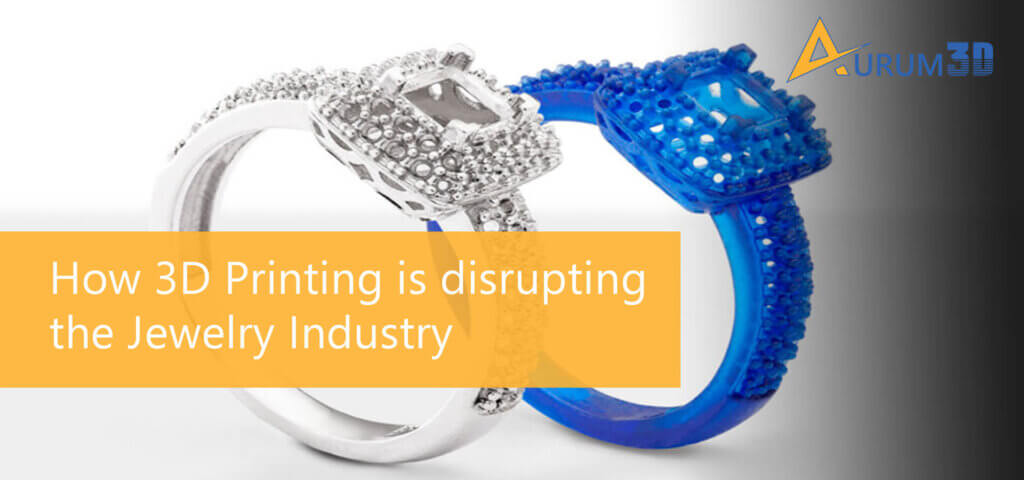The transformative impact of 3D printing technologies on the jewelry industry can be assessed from the consistent growth of the worldwide 3D printed jewelry market.
According to a market research paper released by Technavio, a global technology research and advisory company,
“The global 3D printed jewelry market size is expected to grow by USD 1.95 billion during 2020-2024.”
The growing demand for 3D printed pieces of jewelry suggests that jewelry manufacturers have been replacing commonly used jewelry manufacturing methods – hand fabrication, die striking, low-wax casting, and electroforming – with 3D printing technologies. The leading manufacturers these days create jewelry designs digitally using computer-aided design (CAD) software solutions.
They use high-resolution 3D printers to produce physical patterns based on the digital jewelry design that can be cast in the mold directly. In addition to creating pieces of jewelry with intricate geometries, 3D printing technologies facilitate low-volume production. However, jewelry manufacturers leverage 3D printing to modernize and transform conventional jewelry manufacturing processes in a number of ways.
In addition to 3D printing various pieces of jewelry, manufacturers have been using various 3D printing technologies – fused depositing modeling (FDM), selective laser sintering (SLS), and digital light processing (DLP) – to create prototypes, understand requirements, review design concepts, and offer customization options. That is why; 3D printing technologies have been transforming and disrupting the jewelry industry in a number of ways.
3D Printing in Jewelry Industry: 8 Ways 3D Printing Has Been Disrupting and Transforming the Jewelry Industry
Printing Jewelry Pieces instead of Manufacturing
Many jewelry manufacturers 3D-print pieces of jewelry directly to curtail the time required for customization and manufacturing. They use selective laser melting (SLM) or direct metal laser sintering (DMLS) to print various pieces of jewelry using a variety of metal powder – gold, silver, and platinum. These 3D printing technologies help manufacturers to curtail the time and cost required to produce pieces of jewelry. But the manufacturers have to focus on casting and post-processing to deliver flawless jewelry pieces. Many jewelers and designers these days learn 3D printing to print jewelry using new-generation 3D printers and 3D modeling software.
Producing Complex Jewelry in Parts
Many manufacturers produce complex jewelry pieces in parts through the investment casting process. This 3D printing technology produces pieces of jewelry through a series of steps – pattern formation, mold assembling, shell building, burnout, pouring, knock off, cut off, and finishing. Unlike other 3D printing technologies, investment casting allows manufacturers to accelerate the production of jewelry pieces with intricate features, complex geometries, and a higher level of details. The jewelers can use the investment casting technique to produce multiple pieces of jewelry in a short amount of time.
Experimenting with Metals and Finishing Options
Many manufacturers allow customers to choose from a wide range of metals – gold, silver, platinum, bronze, and brass – while comparing and ordering 3D printed jewelry through their websites. Also, the customers have the option to make the piece of jewelry stand out from the crowd by choosing from a slew of finishing options. For instance, a customer can get unique pieces of gold pieces of jewelry they can choose from multiple color options. Likewise, they can choose from finishing options like color-plating, gold-plating, and chrome-plating to get appealing brass pieces of jewelry.
Accelerating Modification and Customization
Unlike conventional jewelry manufacturing methods, 3D printing produces pieces of jewelry from digital 3D files. The designers and manufacturers can make changes to the 3D files without putting in extra time and effort. The 3D files make it easier for jewelry manufacturers to enable customers to customize and personalize the jewelry designs. The designers can further evaluate and review the customized design by creating plastic prototypes. Hence, 3D printing enables customers to customize and personalize pieces of jewelry on demand.
Reducing Jewelry Prototyping Cost
The jewelry designers and manufacturers have to address a variety of issues while producing a prototype or pattern for casting using conventional methods. But 3D printing technologies enable designers to unleash their creativity and imagination by facilitating rapid jewelry prototyping. A designer can use the appropriate 3D printer to create and review jewelry prototypes with reduced time, cost, and material wastage. Also, he can impress customers by experimenting with varying materials, shapes, geometries, and customization options.
Accelerating Mass Production
In addition to reducing jewelry prototyping time and cost, 3D printing helps manufacturers to accelerate the mass production of jewelry. The manufacture can use the right 3D printer to produce and finetune the master model of the jewelry. The engineers can use the master model to create both high-temperature vulcanized rubber molds and room-temperature vulcanization molds. They can further use SLS 3D printing technology to print multiple pieces of jewelry from the master mold. The 3D-printed pieces of jewelry do not require elaborate post-processing due to the smoothness of the surface finish.
Facilitating Low Volume Production
Many customers these days opt for independent jewelry designers to obtain personalized and unique pieces of jewelry. The independent jewelers cannot curtail the time and cost required to produce unique jewelry pieces using conventional jewelry manufacturing methods. But they can use 3D printing technologies to produce individual or customized pieces of jewelry without increasing production cost or delivery time. They can 3D-print the jewelry directly using the appropriate metal based on the digital 3D file approved by the customer.
Creating Opportunities for Startups
Many startups these days leverage 3D printing technologies to compete with leading jewelry manufacturers. In India, many startups and companies are generating revenue by replacing handmade jewelry with 3D-printed jewelry. Also, some startups leverage 3D printing to provide customers with varying customization options through their websites. At the same time, some startups impress customers by making the 3D printed jewelry appear larger in size without increasing weight.
3D printing technologies are all set to make conventional jewelry manufacturing methods in the longer run. Many jewelry manufacturers these days prefer 3D printing jewelry to manufacture jewelry to save both time and resources. At the same time, 3D printing technologies help manufacturers to automate jewelry designing and manufacturing processes. That is why; worldwide 3D printed jewelry market will grow consistently in the near future.

